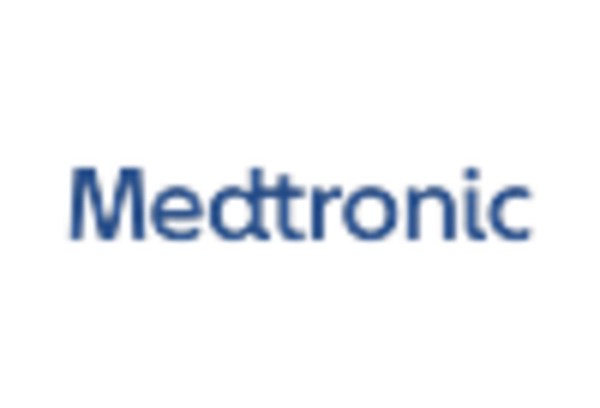Increasing Cardiovascular Disease Prevalence
The rising incidence of cardiovascular diseases in Germany is a primary driver for the transradial access-devices market. As the population ages, the demand for effective and less invasive procedures increases. According to recent health statistics, cardiovascular diseases account for approximately 40% of all deaths in Germany, highlighting the urgent need for innovative medical solutions. Transradial access devices are gaining traction due to their ability to reduce complications associated with traditional femoral access. This shift towards transradial approaches is expected to propel market growth, as healthcare providers seek to enhance patient outcomes and minimize recovery times. The transradial access-devices market is thus positioned to benefit from this growing health concern, as more hospitals and clinics adopt these devices to address the increasing patient load.
Technological Innovations in Medical Devices
The transradial access-devices market is significantly influenced by ongoing technological innovations in medical devices. Advancements in materials and design have led to the development of more efficient and user-friendly access devices. For instance, the introduction of hydrophilic coatings and ergonomic designs has improved the ease of use and patient comfort. Furthermore, the integration of digital technologies, such as real-time imaging and monitoring systems, enhances procedural accuracy and safety. In Germany, the medical device sector is projected to grow at a CAGR of around 5% over the next few years, indicating a robust environment for the transradial access-devices market. As healthcare providers increasingly adopt these advanced technologies, the market is likely to expand, driven by the demand for improved patient care and procedural efficiency.
Rising Demand for Minimally Invasive Procedures
There is a notable shift towards minimally invasive procedures in the healthcare sector, which serves as a significant driver for the transradial access-devices market. Patients and healthcare professionals alike are increasingly favoring techniques that reduce recovery time and minimize surgical risks. The transradial approach, known for its lower complication rates compared to traditional methods, aligns well with this trend. In Germany, the number of minimally invasive cardiac procedures has seen a steady increase, with estimates suggesting a growth rate of approximately 7% annually. This trend is likely to continue, as more practitioners recognize the benefits of transradial access devices. Consequently, the transradial access-devices market is expected to thrive as it caters to the evolving preferences of both patients and healthcare providers.
Supportive Healthcare Policies and Reimbursement Frameworks
Supportive healthcare policies and favorable reimbursement frameworks in Germany are crucial drivers for the transradial access-devices market. The German healthcare system emphasizes the importance of innovative medical technologies, often providing reimbursement for procedures that utilize advanced devices. This financial support encourages hospitals and clinics to adopt transradial access devices, as they can offer improved patient outcomes while maintaining cost-effectiveness. Recent reforms in healthcare policies have further streamlined the approval process for new medical devices, facilitating quicker market entry. As a result, the transradial access-devices market is likely to experience growth, driven by the increasing adoption of these devices in clinical practice, supported by a conducive regulatory environment.
Growing Awareness and Education Among Healthcare Professionals
The growing awareness and education among healthcare professionals regarding the benefits of transradial access devices is a vital driver for the market. Continuous medical education programs and workshops are being organized to inform practitioners about the advantages of transradial approaches, such as reduced bleeding complications and shorter recovery times. In Germany, medical institutions are increasingly incorporating transradial techniques into their training curricula, fostering a new generation of healthcare providers skilled in these methods. This educational push is expected to enhance the adoption of transradial access devices, as more professionals become proficient in their use. Consequently, the transradial access-devices market stands to gain from this trend, as a well-informed workforce is likely to drive demand for these innovative solutions.

















Leave a Comment